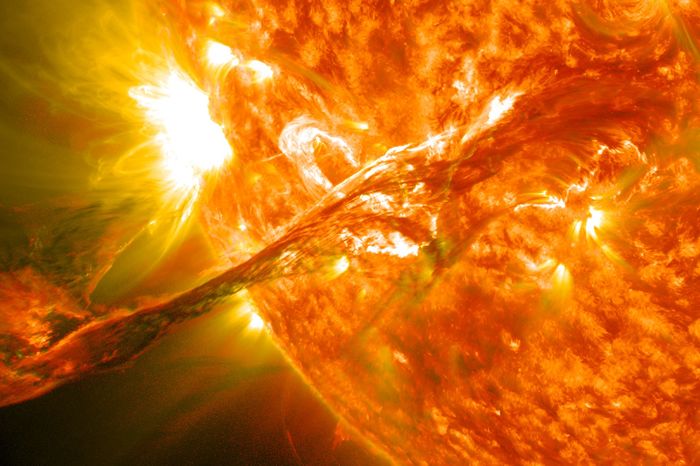Research Round-up: what you missed over the summer
Maya Kunchur gets you up to date on some of the latest scientific discoveries

Life on Mars or Europa?
NASA has confirmed its Europa Clipper flight should go ahead on schedule. The Clipper is planned to launch around October 10th and land on Jupiter’s moon Europa in April 2030.
Europa is of particular scientific interest because it has an ice crust, below which scientists are almost certain lies a vast salt-based ocean, larger than all of Earth’s oceans combined. This is partially theorised based on the behaviour of Europa’s magnetic field. As far as we know, life requires water, so its presence is the first hint that the moon holds the potential to support life. Another requirement for life is sufficient energy: despite Europa’s distance from the Sun, energy is transferred as a result of tides induced by Jupiter’s strong gravitational field.
"The Clipper is specially designed to endure Jupiter’s immense gravitational pull (close to 20,000 times stronger than Earth’s)"
The Europa Clipper will measure the ocean’s depth and salinity, as well as how deep the ice crust is. It will also search for traces of some of the other building blocks of life as we know it, such as carbon, hydrogen, oxygen and sulphur. The Clipper is specially designed to endure Jupiter’s immense gravitational pull (close to 20,000 times stronger than Earth’s) and is decorated with poetry, artwork and over 2 million names.
Can scientists see right through you? This technology could turn skin transparent
Scientists have discovered that a yellow food dye used in Doritos can turn living tissues transparent. It works by influencing how much light is scattered.
Different molecules and materials make up a living tissue; lipid, protein, fluids and more. As light reaches the boundaries between each of these materials it is both scattered and refracted, bending in a different direction. This is the same phenomenon which means a straw in a glass of water looks disjointed above and below the water’s surface.
Fluids and lipids have very different refractive indices, which means a lot of light is scattered between them, causing a tissue to appear opaque. When this dye is dissolved in water it decreases the difference between the refractive indices so more light can pass across the boundary, giving a transparent appearance.
"When this dye is dissolved in water it decreases the difference between the refractive indices"
The dye, known as tartrazine or FD&C Yellow 5, was first tested on raw chicken breast and has since been tested on mice. Scientists were able to see a mouse’s intestines and organs when the dye was applied to its belly and viewed under red light, as well as blood vessels in the brain when applied to the scalp.
The discovery is particularly useful because tartrazine is a common food dye, so it is non-toxic and the effects can be completely reversed by rinsing it off. Currently, it can only be used to see depths of around 3mm, but potential uses include helping a phlebotomist more easily find a blood vessel. Additionally, scientists often study naturally transparent organisms (e.g. Zebrafish) to easily see structures develop but with this dye, other organisms could be studied in a similar way.
Is electric flight about to take off?
Electric or hybrid cars are no longer a rare sight on the roads, but it could take longer to get used to the idea of a battery-powered aeroplane. The Velis Electro is one of the first. It is powered by two lightweight lithium batteries in a powertrain which is liquid-cooled to stabilise its temperature. This design overcomes the two most common problems in electric flight: weight, and heat.
"Current models of electric planes are only suitable for short-haul flights"
Currently, aviation accounts for just over 2% of CO2 emissions and 4% of global warming. As the market is projected to keep growing rapidly, alternatives will need to be developed fast to prevent this number continuing to rise. Of course, batteries still require non-renewable components and lithium mining has no small carbon footprint. However the Visio Electro produces no carbon emissions during operation, so this appears to be a step in the right direction.
Current models of electric planes are only suitable for short-haul flights, which account for just 20% of the aviation industry’s impact on global warming: there is a long way to go. However, these planes provide hope for change, and there are many of them in development to keep an eye on. Pipstrel, the company behind Visio Electro, is working on other projects such as the Unifer 19. This plane is being designed under an EU initiative for a reduced carbon-emitting and less noisy ‘mini liner’ for short-haul flights in Europe.
 News / CUP announces funding scheme for under-represented academics19 December 2025
News / CUP announces funding scheme for under-represented academics19 December 2025 News / Cambridge welcomes UK rejoining the Erasmus scheme20 December 2025
News / Cambridge welcomes UK rejoining the Erasmus scheme20 December 2025 Comment / Yes, I’m brown – but I have more important things to say22 December 2025
Comment / Yes, I’m brown – but I have more important things to say22 December 2025 News / SU reluctantly registers controversial women’s soc18 December 2025
News / SU reluctantly registers controversial women’s soc18 December 2025 Film & TV / Timothée Chalamet and the era-fication of film marketing21 December 2025
Film & TV / Timothée Chalamet and the era-fication of film marketing21 December 2025









